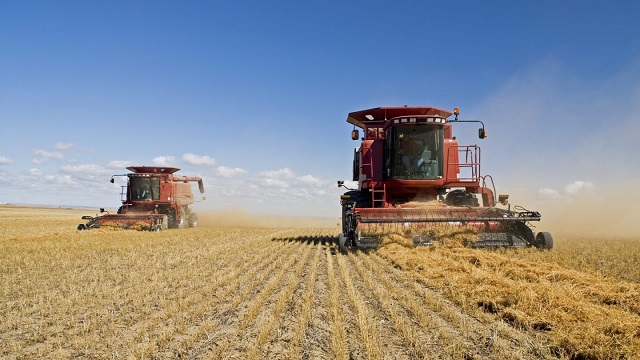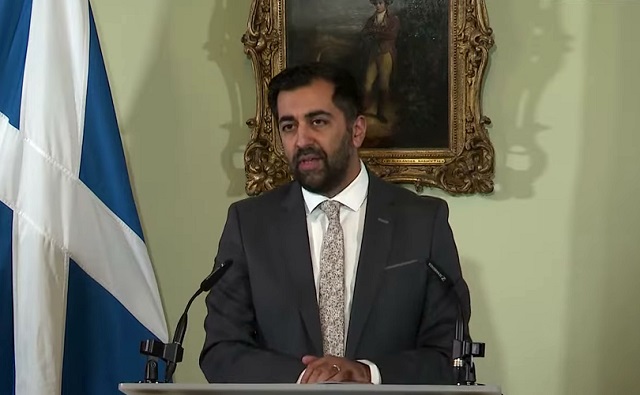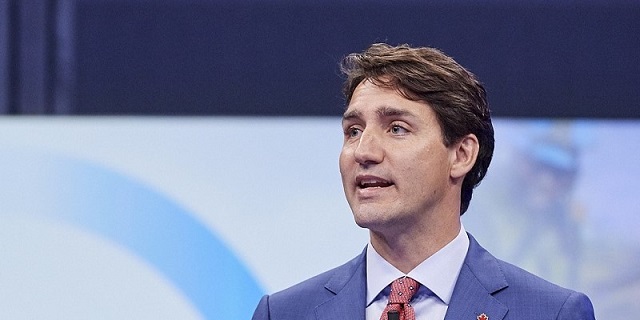Energy
Biden chose Venezuela over Canada for oil
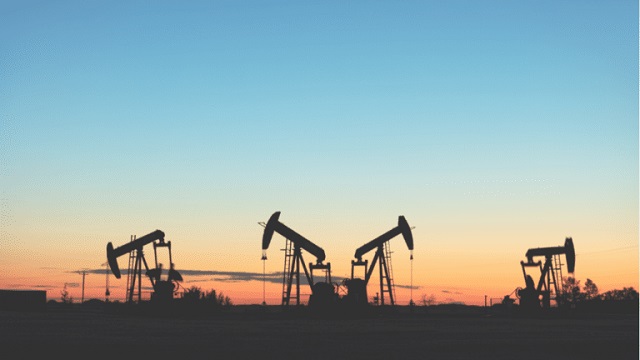
From the MacDonald Laurier Institute
By Brian Lee Crowley
Biden is welcoming oil from one of Latin America’s most odious regimes. It’s a big win for Nicolás Maduro, but a bad deal for America and Canada
The United States needs more heavy oil for a whole series of reasons. President Joe Biden could have chosen to have that oil come from a close friend and ally, environmentally-conscious Canada, or from one of the world’s nastiest regimes, Nicolas Maduro’s Venezuela, which doesn’t give a toss about the environment. Which did he choose?
In exchange for modest concessions on electoral reform, the Biden administration just lifted sanctions on Venezuela, allowing them to export hundreds of thousands of barrels a day of vital heavy oil to the United States. The shale oil revolution has not and cannot change the fact that the US produces virtually no heavy oil, yet many of this country’s refineries, especially on the Gulf Coast, were set up to refine that kind of oil. Most of their heavy oil is from Canada, which is why that country is far and away the largest exporter of oil to America— more than twice as much as Saudi Arabia, Mexico, Russia, and Colombia combined. If America is now a net exporter of oil, it can thank Canada.
The war in Ukraine caused unpopular price hikes at the gas pump. In response, the Biden administration has drawn down the Strategic Petroleum Reserve (SPR). That drawdown focused on medium and heavy crudes. OPEC responded with supply cuts aimed at throttling the supply of these strategically important crudes.
The drawdown of the SPR is reaching its limits but the risk of higher gas prices in an election year is rising. To OPEC and Ukraine, we must now add the heightened risk of conflict spreading in the Middle East.
In this context, recall that one of the very first acts President Biden took on reaching office was to cancel the permit for the Keystone XL (KXL) pipeline, a permit issued by his predecessor. Keystone XL was intended to provide 830,000 barrels a day of Canadian heavy crude to those Gulf Coast refineries. Pipe was already being laid.
Had President Biden allowed KXL to proceed, the supply of heavy oil to the US industry would have been secure, risky drawdowns of the SPR unnecessary and America would have been much less vulnerable to global supply disruptions and OPEC’s manipulations.
Instead, the President colluded with a campaign to vilify oil from Alberta’s oilsands as “dirty oil.” Yes, producing Canada’s heavy oil emits greenhouse gases. But then all heavy oil is GHG intensive, and Venezuela is the highest emitting in the world.
The Canadian oil & gas sector has invested heavily and successfully in emissions reductions. The industry has a $75 billion plan to decarbonize and achieve net zero by 2050, focused on carbon capture and storage and small modular nuclear reactors.
Venezuela has done nada in terms of real improvement in the environmental footprint of its heavy oil production. What it does have is a regime that is world-leading in terms of its human rights abuses and the damage it has inflicted on a once-prosperous economy. Every dollar America spends on Venezuelan oil will prop up one of the most violent and repressive regimes in the Americas, where Amnesty International says in 2022:
The security forces responded with excessive force and other repressive measures to protests…to demand economic and social rights, including the right to water. Impunity for ongoing extrajudicial executions by the security forces persisted. Intelligence services and other security forces, with the acquiescence of the judicial system, continued to arbitrarily detain, torture, and otherwise ill-treat those perceived to be opponents of the government of Nicolás Maduro.
A recent UN Fact Finding Mission to Venezuela talked about the “unremitting human rights crisis” and patterns of crimes against humanity in that country. Nearly 8 million Venezuelans are estimated to have fled the economic and humanitarian crisis there.
Meanwhile, Canada, while not perfect, has robust human rights protections and high environmental standards. It is also a magnet for immigrants (including tens of thousands of Venezuelans), having one of the highest shares of its population born elsewhere in any country in the world.
In 2021 President Biden was happy to offend one of America’s closest allies by blocking KXL because it was inconsistent “with my administration’s economic and climate imperatives.” Three short years later, behind the fig leaf of Venezuelan electoral reform, he is welcoming much more environmentally damaging oil from one of Latin America’s most odious regimes, all to try and keep the price down at the pump. That’s a big win for Nicolás Maduro, but a bad deal for America and Canada.
Brian Lee Crowley is the Managing Director of the Center for North American Prosperity and Security (www.cnaps.org).
Energy
Pope Francis calls for ‘global financial charter’ at Vatican climate change conference
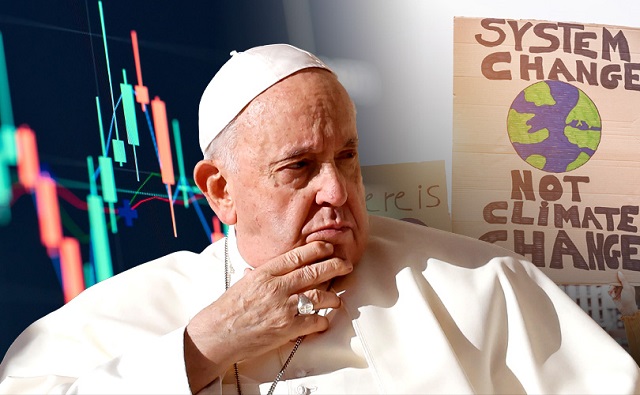
From LifeSiteNews
By Michael Haynes, Snr. Vatican Correspondent
Pope Francis called for a ‘new global financial charter’ by 2025 which would be centered on climate change and ‘ecological debt’ in a keynote address at the Vatican-organized ‘Climate Crisis to Climate Resilience’ conference.
Addressing a Vatican-hosted climate change conference, Pope Francis called for a “new global financial charter” by 2025 which would be centered on climate change and “ecological debt.”
“There is a need to develop a new financial architecture capable of responding to the demands of the Global South and of the island states that have been seriously affected by climate catastrophes,” said Pope Francis on Thursday, May 16.
The Pontiff’s words came towards the end of his keynote address at the conference “Climate Crisis to Climate Resilience,” organized jointly by the Vatican’s Pontifical Academy of Sciences and Pontifical Academy of Social Sciences.
JUST IN: #PopeFrancis urges @CasinaPioIV climate change conf to work for “global de-carbonization” adding: “The data emerging from this summit reveal that the specter of climate change looms over every aspect of existence, threatening water, air, food and energy systems.”… pic.twitter.com/t7cV4ne0s4
— Michael Haynes 🇻🇦 (@MLJHaynes) May 16, 2024
Outlining a three-fold action plan to respond to the “planetary crisis,” Francis told the participants that any such action must be centered around financial action.
“The restructuring and reduction of debt, together with the development of a new global financial charter by 2025, acknowledging a sort of ecological debt – we must work on this term: ecological debt – can be of great assistance in mitigating climate changes,” he said, appearing to allude to an already existing, but as yet unpublished, charter.
The Pope’s three-fold plan also highlighted his call for “policy changes” based on climate adherence and the reduction of warming, fossil fuel reliance, and carbon dioxide:
First, a universal approach and swift and decisive action is needed, capable of producing policy changes and decisions. Second, we need to reverse the curve of warming, seeking to halve the rate of warming in the short space of a quarter of a century. At the same time, we need to aim for global de-carbonization, eliminating the dependence on fossil fuels.
Third, large quantities of carbon dioxide must be removed from the atmosphere through environmental management spanning several generations.
Francis’ call for finance-related policies to implement climate change goals will have been met especially warmly by certain attendees of the Vatican’s conference. Among the numerous participants and speakers at the three-day event were ardent pro-climate change advocates California Gov. Gavin Newsom, London’s Mayor Sadiq Khan, New York Gov. Kathy Hochul, Massachusetts’s lesbian Gov. Maura Healey, along with academics and politicians from South America, Africa, Italy, and Taiwan.
Newsom and Khan – both of whom have implemented sweeping and highly controversial measures in the name of climate change – spoke respectively on “The Gold Standard – Climate Leadership in the Golden State” and “Governance in the Age of Climate Change.” Khan also wrote in the U.K.’s The Tablet that he joins his voice to that of Francis “to support climate resilience efforts and advocate for climate justice.”
Green finance for the future
While no further details were given about the charter Pope Francis referred to, in recent years increased attention has been paid to coordinating climate policies with finance, performing “debt for nature swaps” in line with the World Economic Forum’s policies, and addressing “ecological debt” itself, which is a term itself employed regularly by Francis.
Last October 4, Francis published a second part to his 2015 environmental encyclical letter Laudato Si’ in the form of the Apostolic Exhortation Laudate Deum, in which he issued stark calls for “obligatory” measures across the globe to address the issue of “climate change.”
READ: Pope Francis calls for obligatory global ‘climate change’ policies in new document ‘Laudate Deum’
“It is no longer possible to doubt the human – ‘anthropic’ – origin of climate change,” wrote the Pontiff, before later calling for mandatory alignment with “green” policies:
If there is sincere interest in making COP28 a historic event that honors and ennobles us as human beings, then one can only hope for binding forms of energy transition that meet three conditions: that they be efficient, obligatory and readily monitored.
Francis’ oft-repeated lines on the subject have repeatedly born similarities to the sentiments expressed by key globalist and founder of the World Economic Forum (WEF) Klaus Schwab, whose proposed anti-Catholic “Great Reset” is underpinned by a focus on a “green” financial agenda, as he mentions the “withdrawal of fossil-fuel subsidies” and a new financial system based on “investments” which advance “equality and sustainability” and the building of a “‘green’ urban infrastructure.”
Indeed, the world of finance is one of the sectors that is most devoted to implementing “climate change” policies, such as those outlined by the Paris Agreement – the pro-abortion climate agreement to which the Vatican joined in 2022.
A lesser-known third aim of the Paris Agreement pertains directly to the financial element of the document, ensuring that the future of global finance is directly connected to the various climate change efforts laid out in the Paris Agreement. It reads:
Making finance flows consistent with a pathway towards low greenhouse gas emissions and climate-resilient development.
This aim provides the basis for international governments to link provision of finance to the implementation of the “green” agenda of the Paris Agreement. The almost unknown Network of Central Banks and Supervisors for Greening the Financial System (NGFS) was born at the Paris “One Planet Summit” in December 2017, with the purpose of transforming the global economy in alignment with “green” climate change policies.
READ: Secretive international banking group may enforce Great Reset ‘green’ agenda on world
Already, it numbers 138 members, with an additional 21 observer organizations, including national and international banks such as the “Bank of Canada; Bank of England; Banque de France; Dubai Financial Services Authority; European Central Bank; Japan FSA; People’s Bank of China; Swiss National Bank; U.S. Federal Reserve.”
Such policies are regularly at the forefront of international finance meetings as well. One such example was last year, when French President Emmanuel Macron called for a “public finance shock” based around climate issues and global finance. His address was given to international leaders at the 2023 Summit for a New Global Financial Pact, held in Paris.
Energy
LNG leader: Haisla Nation Chief Councillor Crystal Smith on the world’s first Indigenous project
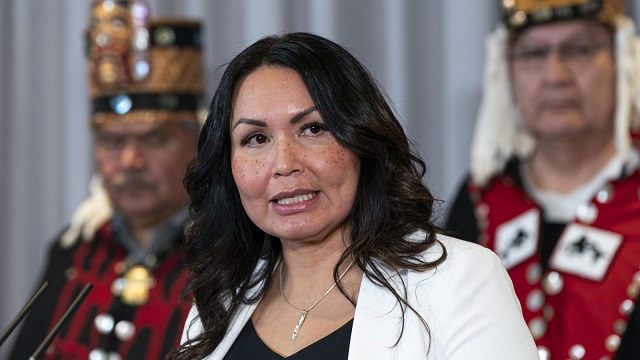
Haisla Nation Chief Councillor Crystal Smith during a press conference announcing that the Cedar LNG project has been given environmental approval in Vancouver, Tuesday March 14, 2023. CP Images photo
From the Canadian Energy Centre
By Will Gibson‘Now we are working together to make our own opportunities as owners and developers of the resource’
Growing up in the 1980s, Crystal Smith felt supported and nourished by her community, the Haisla Nation along the shores of Kitimat, British Columbia. But at the same time, she also sensed the outside world had placed some limitations on her future.
“I enjoyed a wonderful childhood with a solid foundation and lots of love, especially from my grandma Cecilia Smith. She raised me because I lost my mother and stepdad at a young age. But it wasn’t popular to be Indigenous when I grew up,” says Smith.
“A lot of people would talk about how Indigenous people were not expected to be successful. That kind of talk really affected my confidence about what I could be.”
Smith, now the Haisla Nation’s elected chief councillor, never wants children in her community to feel those constraints.
Her community has seized on a major opportunity to build prosperity and resiliency for future generations. The Haisla Nation is a partner in the proposed $3.4 billion Cedar LNG project, the world’s first to have Indigenous ownership. A final go-ahead decision for the project to proceed is expected by the middle of this year.
Smith, who has served as board chair of the First Nations LNG Alliance since 2019, has already seen tangible changes in her community since the project was announced.
“It’s hard to put into words about the impact on the ground in terms of how this opportunity has affected our members in their lives,” she says.
“We were just interviewing candidates to serve as board directors on our economic development corporation and one candidate, who is from our community, just amazed me with how far he has come in terms of pursuing his education and how much his career has progressed.”
 The town of Kitimat on British Columbia’s west coast. LNG Canada site in background. Photo courtesy District of Kitimat
The town of Kitimat on British Columbia’s west coast. LNG Canada site in background. Photo courtesy District of Kitimat
Of her own career, Smith says she knew since college that her future was in serving the community. She started working in the Haisla band administration in 2009 and was first elected chief councillor in 2017.
“I was lucky because my family really pushed me to seek an education after high school, so I took the business program at Coast Mountain College. I also helped that I had mentors in my community, including my father Albert Robinson, who served as an elected Haisla councillor, and Ellis Ross (now an elected MLA in B.C), who was very inspiring in terms of his vision as chief councillor and encouraged me to take the step into elected office,” Smith says.
“When I came back to the community from school, I knew I would end up working in our band office. I wanted to see more opportunities for people in my community and LNG provides that.”
She already sees the benefits of the development, as well as the Haisla Nation’s participation in the LNG Canada project, within her own family including for her grandsons.
“Xavier is six and he goes to the same school I attended as a child. He gets to learn parts of our culture, our teachings, as well as the value and importance of family and community. There’s more of an emphasis on our language and culture in the curriculum, which really makes me happy. Luka, who just turned two, will also attend that school when he’s old enough,” Smith says.
“I want programs and services to meet our needs, not the level of government’s needs. And we need to make sure that it is sustainable not just for my grandsons or their peers but for seven generations beyond this one.”
Cedar LNG is coming closer and closer to fruition, with all permits in place and early construction underway.
An eight-kilometre pipeline will be built connecting the recently completed Coastal GasLink pipeline to deliver natural gas to the floating Cedar LNG terminal located along the Douglas Channel near Kitimat.
The facility will be capable of producing up to three million tonnes of liquefied natural gas every year, which will be transported by carriers through the Douglas Channel to Hecate Straight, using the existing deepwater shipping lane, to reach customers in the Asia-Pacific region.
Powered entirely by renewable energy from BC Hydro, Cedar LNG will be one of the lowest carbon intensity LNG facilities in the world. Its so-called emissions intensity will be 0.08 per cent CO2 per tonne, compared to the global average of 0.35 per cent per tonne.

Up to 500 people will work on the project during the peak of construction. Approximately 100 people will be working at the facility full-time during operation, which is expected to start in the second half of 2028.
Smith says the benefits of the project will extend beyond the 2,000 members of the Haisla Nation.
“This work has really helped us reconnect with other Indigenous communities along pipelines and shipping routes,” she says.
“When I was growing up, our communities never had the opportunity to come together because we were separated by the territorial boundaries imposed by the Indian Act. And we were fighting each other for financial scraps from Indian Affairs.
“Now we are working together to make our own opportunities as owners and developers of the resource. That’s very empowering and the most important part. Participating in developing these resources provides independence. It’s the only solution for my nation and other Indigenous communities.”
-
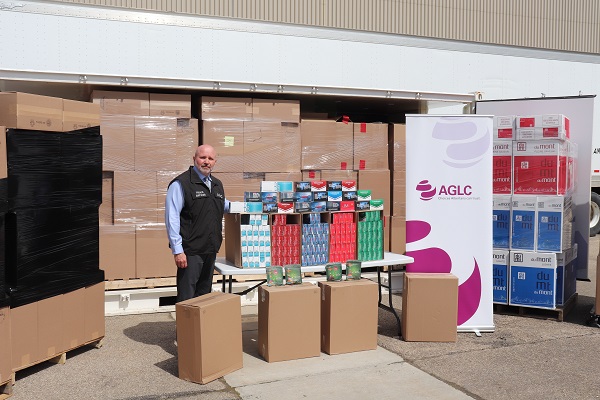
 Alberta2 days ago
Alberta2 days ago30 million contraband cigarettes valued at $25 million dollars seized in Alberta
-
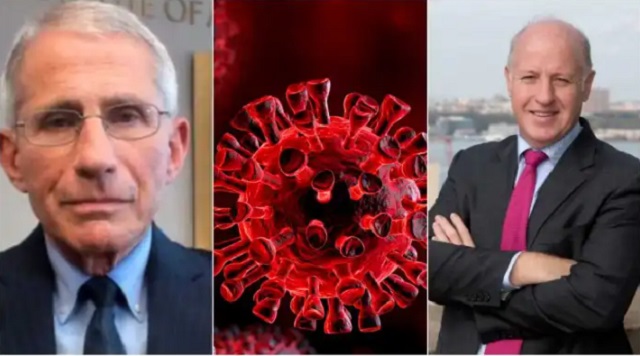
 COVID-1919 hours ago
COVID-1919 hours agoCOVID Lab Leak: Over four later, EcoHealth Alliance funding is finally suspended
-

 Alberta2 days ago
Alberta2 days agoPharmacist-led clinics improve access to health care: Lessons from Alberta
-

 Automotive2 days ago
Automotive2 days agoGovernments in Canada accelerate EV ‘investments’ as automakers reverse course
-
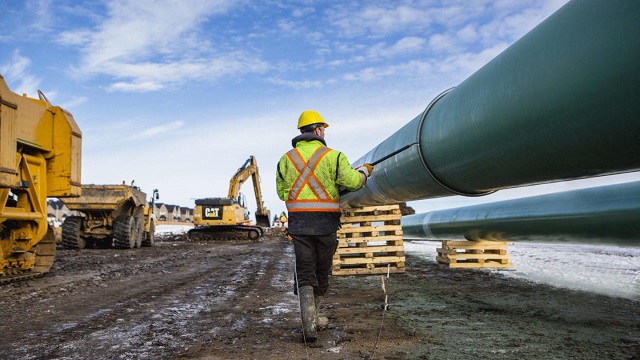
 Canadian Energy Centre2 days ago
Canadian Energy Centre2 days agoTrans Mountain completion shows victory of good faith Indigenous consultation
-
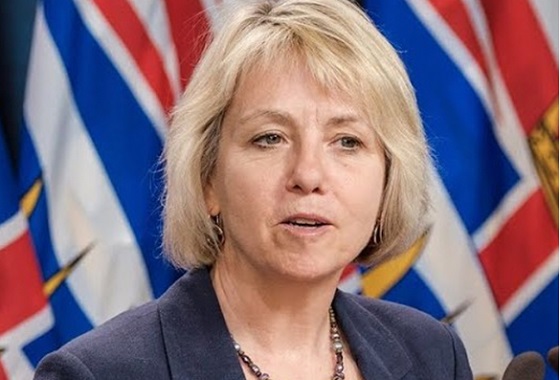
 COVID-192 days ago
COVID-192 days agoHealthcare workers obtain partial win against Bonnie Henry in BC Supreme Court
-

 COVID-191 day ago
COVID-191 day agoElon Musk-backed doctor critical of COVID response vows appeal after court sides with medical board
-

 Health1 day ago
Health1 day agoSouth Korean president declares low birth rate a ‘national emergency,’ plans new ministry to address it




